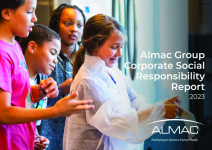THE FUTURE OF CLINICAL TRIALS
FDA leader discusses breaking barriers in clinical care

With more than three decades of experience at the US Food and Drug Administration (FDA), acting commissioner Janet Woodcock has an informed perspective of the government’s contributions to pharmaceutical development, drug safety, and clinical research. She’s seen the agency work closely with the National Institutes of Health, she said, and witnessed “tremendous progress” on encouraging a stronger focus on the clinical trials included in government grants.
“The experience we’ve had working and trying to deal with the coronavirus has shown the power of everybody working together,” she told Outsourcing-Pharma. “The vaccine trials were sponsored by the industry, but then the NIH and FDA assisted them in design and enrollment, making sure they got representative populations enrolled and so forth."
Still, Woodcock remarked, most US agency representatives and leaders are on the same page about the need for additional progress, particularly regarding the inclusivity of studies.
“There’s a collective agreement that more needs to be done, with a focus now on health equity and diversity,” she said. “You need to reach into these underserved areas and offer them opportunities to participate—if no one ever even mentioned to you that you could enroll in a clinical trial, that's a big problem, so things do have to change.”
One suggestion Woodcock offered is improving the way patients enter and participate in clinical trials, so they aren’t losing the connection to their caregivers when they enroll in a study.
“We need to change trials so we're not taking the patients away from the doctors so that they can be cared for by their same doctors and in their same community, and so that enough support is offered,” she said.
Too often, Woodcock explained, there’s a disconnect between the healthcare professionals providing care to the patient for a specific condition, and the trial system working on a novel therapy for that condition.
“Maybe there’s a PI they have to go see once, but then their local doctor can handle most of the care,” Woodcock said. “One of the barriers is that physicians don’t want to refer people to clinical trials, because then they might never see that patient again.”
In an earlier part of this series, Javara Research CEO Jennifer Byrne wondered if bringing hospital and clinic systems into the research system might not lead to stronger connections along the clinical trial pipeline, and to improved patient access to clinical care. Woodcock said she agrees bringing healthcare systems into the fray might be helpful.
“I've talked to the folks [Byrne] works with, and the CEOs and others in the healthcare system, regarding access to research as an essential part of care, and that's probably the conceptual shift that has to occur,” she said. “Right now we have care over here on one hill, and we have clinical research on a different hill—the concept that needs to be advanced is that access to research protocols is part of care delivery, and it's a service that systems should deliver to their patients to get the very best care.”
While such discussions are part of the necessary continuous improvement of clinical research, Woodcock said, the system could stand to be more organized and less “onerous.”
“As [former FDA commissioner] Rob Califf has pointed out numerous times, most clinical guidelines are not evidence-based,” Woodcock remarked. “They're based on expert opinion because we don't study and treat healthcare as something we can continuously improve by experiment—we treat manufacturing that way, and Google treats advertising that way, but with healthcare, it’s whatever that person was trained with, how much they’ve kept up with, and so forth.”
In the previous part of this series, Woodcock suggested the FDA and other leaders encourage the creation of a national clinical trial “stockpile,” so that patients, researchers, providers, and other important components are at the ready, especially important in the event of the next pandemic. She pointed toward the success of the I-SPY breast cancer research platform rapidly setting up a COVID-19 study in the ICU at a crucial point in the pandemic.
“It takes time but you have to have that capacity and readiness; otherwise, it'll take you years to build up that capacity,” she said.
One helpful shift in the healthcare system mindset, Woodcock suggested, would be if instead of seeing clinical research as outside their realm, they instead viewed it as an important part of care. However, she advised, while clinical researchers could benefit from a stronger connection with healthcare systems and providers, this structure might work best if pharmaceutical firms remained more outside that framework.
“I've always thought we should have independent people running the trial networks who are not associated with pharmaceutical,” she said. “I feel like the drug companies should support the infrastructure development, but I don't think they should run it.”
And, Woodcock remarked, even if physicians and healthcare executives are given a part to play in an improved trial infrastructure, clinical research professionals will still be leading the way.
“The clinical researcher won’t be left out of this new equation; they’re the experts in how to evaluate new interventions, design trials, analyze the results,” she said.
And, Woodcock said, it’s important to build awareness among the public of clinical trials and the vital role they play in the equation so that they (for example) can be involved earlier in the process if another pandemic strikes.
“If the community hasn’t been part of research and don’t feel they’re a part of the research enterprise, how likely are they to pick up on these new innovations?” she said. “That’s why having patients and community clinicians engaged in the research enterprise will help in bringing those two things back together. It’s much better to have the community, both the patients and their caregivers, participate in the research, so that they have ownership.”















